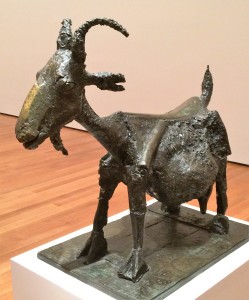I'll Have a Picasso, S’il vous plait
At this once-in-a-lifetime exhibition, Picasso Sculpture, at the Museum of Modern Art through February 7, 2016, the viewer is treated to wonderful insights into the artist’s work. It's an epic showing of 140 pieces, arranged chronologically, with the sculptures occupying the museum’s entire fourth floor.
What becomes clear as you walk from gallery to gallery is that sculpting was an integral, if spasmodic, part of Picasso's life. In 1902, at the age of 20 and still living in Barcelona, he created a clay model known as Seated Woman. Five years on, Picasso would have a mind-altering moment when he visited the collection of African and Oceanic sculptures at the Musée du Trocadero in Paris. That visit, which had come about at the suggestion of the great painter André Derain, stimulated the young Picasso to try his hand at wood carving.
At this same time, Picasso and his friend, Georges Braque, were exploring in their paintings the juxtaposed forms that would become a new way of seeing, what we now call Cubism.
In the assemblage to the left, The Guitar, Picasso has already broken with conventional norms in that this sculpture is not of stone or bronze, but of wood. Then, too, there is the sense of space and airiness, an opening to the world that refutes all that has gone before.
Head of a Woman, 1909—one of the few pieces ever exhibited in Picasso's lifetime in a gallery—is from that period. Other artists would say of it that Picasso had taken the static form of sculpture and infused it with a sense of possibility and of moving through time. Also from this period is Picasso’s revolutionary painting, Les Demoiselles d'Avignon, 1907, on view in the fifth floor galleries at MoMA.
Last month in a Desperately Seeking Paris blog-post on 'Le Musée Picasso,' Head of a Woman, now spending a few months in New York, could be seen at the top of the staircase at that museum in Paris. Click on the link above and take a look. The light-filled museum, its historical setting, and the comprehensive collection are glorious.
Picasso Sculptures, spanning the years 1902-1964, offers a breathtaking overview of the inventiveness and playfulness that Picasso brought to sculpture. Although not a trained sculptor, he reinvented the discipline with non-traditional materials such as wood, wire, sheet metal, cardboard and plain-old everyday objects. Be so doing, he overturned centuries of artistic practice.
As the viewer passes from one gallery to another, the chronological arrangement of the sculptures affords a fuller understanding of the evolving nature, not only of the thinking of the artist, but of the discipline itself.
Gone is any likeness to the magnificent bronze sculptures of Auguste Rodin. Gone, too, any similarity to the ethereal works carved in marble by the French sculptor, Jean-Baptiste Carpeaux. Only a few years ago, Carpeaux was given his own show at the Metropolitan Museum of Art. Picasso replaces the heaviness and solidity normally associated with sculpture with a lightness of being, with air and space.
The improvisational sculptures were deeply personal. Picasso kept them with him, never selling a one throughout his lifetime. He hated to part with them, even for brief periods. To the left is the stunning Woman with Vase which he did contribute to the Spanish Pavilion, along with the great antiwar mural, Guernica, which he painted for the 1937 World's Fair in Paris.
Only upon his death did his sculptures become a part of the founding of the Musée national Picasso in Paris. Thanks to that museum and to a number of other lenders, MoMA has been able to give viewers a deeper understanding of the works of this 20th century genius.
The sculptures tell an amazing story, only a small part of which I can show you. Best to go see it for yourself before it closes in two months. I'll be going back, for sure.
And when I do, you'll find me drinking coffee on the terrace café overlooking the Abby Aldrich Rockefeller garden and when the waiter asks what I'd like, I'll say: "I'll have a Picasso, please."
I hope the curators will put The Goat back in the garden. Thanks for stopping by, hope to see you next Sunday. Rest assured, I'll have the coffee ready.
Now, if you have enjoyed gallery-hopping with me at MoMA, would you take a second to share this post with friends and family? Merci beaucoup mes amis.








